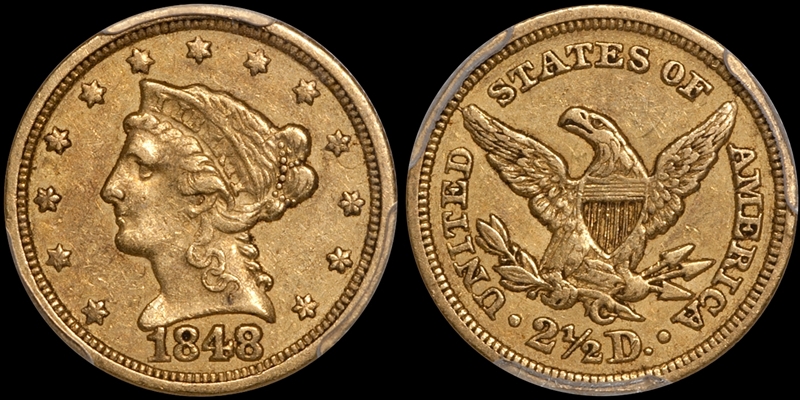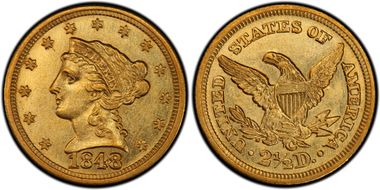1848-C $2.50 XF45 认证号84136472, PCGS号7750
拥有者评论
CAC
专家评论
Doug Winter
The 1848-C is a reasonably available coin from the standpoint of the total number known to exist. However, it is very rare and still underrated in higher grades. Much of its rarity has to do with its quality of strike.The 1848-C quarter eagle is an issue that is usually found well worn and weakly struck. It can be very difficult to locate a pleasing, original specimen that grades higher than AU50 to AU55, and it is a rare coin in properly graded AU58. While a fairly significant number of pieces have been graded Uncirculated..., I still have never seen an 1848-C that I thought was unquestionably Mint State.
STRIKE: The strike seen on the 1848-C Quarter Eagle varies greatly. There are some fairly well struck pieces but these are quite scarce. Most are not well impressed and others show extremely poor obverse detail due to having been produced from a buckled die. The sharply struck pieces (which total around 25% of the surviving population) have some minor weakness at the top of Liberty’s head and the eagle’s right leg while the other details are fairly sharp. Those coins with what could be called “typical” strike (around 60% of the surviving population) show more weakness at the centers and these can be quite soft on the head of Liberty and at the lower obverse. Coins that are struck from fully buckled dies are rare and these account for around 15% of the surviving population. On the buckled die coins, the obverse is very weak with the ER in LIBERTY especially faint as well as with noticeable lack of detail on the stars and on the hair. The reverse appears sharper with the exception of the eagle’s head and neck which are almost completely void of detail.
1848-C Quarter Eagles that are struck from buckled dies, while certainly interesting, are not considered desirable by collectors and they usually sell at a discount compared to those examples that are well detailed.
SURFACES: The 1848-C Quarter Eagle is prone to display heavy abrasions on the surfaces. A number have mint-made striations in the fields, especially on the obverse. This is one of the hardest Charlotte quarter eagles to find with choice surfaces.
LUSTER: This date shows below average luster. On some of the higher grade coins, the luster is satiny with a pronounced grainy texture. A few of the late die state buckled die coins are seen with reflective, semi-prooflike fields. This is one of the most difficult Charlotte Quarter Eagles to find with good luster.
COLORATION: The natural coloration is often dark and not very appealing. Many of the remaining original coins have a dark green-gold hue. Some show a lighter yellow-gold shade and this is considered by collectors to be more desirable. Most have been cleaned or repeatedly dipped and pieces with nice natural hues are very rare.
EYE APPEAL: The only 1848-C Quarter Eagles with good eye appeal are these which show a good strike. This issue is extremely hard to locate with above average eye appeal and the few high quality pieces which exist typically trade for substantial premiums over typical low-end examples.
DIE CHARACTERISTICS: All examples have numerous raised die lines which run down from the final star to the 8 in the date. On some, there is some light die rust on the reverse.
DIE VARIETIES: There are two die varieties.
Variety 1 (formerly Variety 9-F): The 1 in the date is joined to the bust and it is close to the denticles. The second 8 is closer to the denticles than to the bust. The date is very heavy and it slants downwards noticeably to the right. The reverse was also employed in 1846 and 1847; it now shows a stronger crack from the bottom of the M in AMERICA to the left wing.
Variety 2 (formerly Variety 10-F): The 1 in the date is joined to the bust while the 8 is closer to the bust than on the other obverse. The date is also heavy but it is better centered and it does not slant downwards. The bases of the 1 and the 4 are repunched to the left.
At least three states are known:
Die State I: The obverse is slightly buckled with some weakness seen at the center. The reverse shows weakness as well, although not as much as the obverse. The reverse crack mentioned above shows clearly.
Die State II: The obverse shows more buckling and the strike becomes weaker in the center. The reverse weakens further as well.
Die State III: The obverse is totally buckled and it is very weakly detailed. The reverse shows near-total loss of detail on the head of the eagle. The overall sharpness, however, remains bolder than on the obverse. An example of this die state is Bass II:414 which is probably the discovery coin.
David Akers (1975/88)
Very scarce in all grades. I have never seen a full mint state 1848-C, although I have seen three or four very nice AU's. Usually weakly struck, particularly on the obverse stars and on the hair above Liberty's forehead. Sharply struck pieces are seldom encountered.PCGS #
7750
设计师
Christian Gobrecht
边缘
Reeded
直径
18.00 毫米
重量
4.18 克
铸币数量
16788
金属成分
90% Gold, 10% Copper
更高评级数量
62
评级较低的钱币数量
59
地区
The United States of America
价格指南
PCGS 数量报告
拍卖 - PCGS 评级的
拍卖 - NGC 评级的
稀有性和存量估计 了解更多
| 所有评级 | 175 |
| 60或以上 | 3 |
| 65或以上 | 0 |
| 所有评级 | R-7.2 |
| 60或以上 | R-9.8 |
| 65或以上 | R-10.1 |
| 所有评级 | 68 / 147 TIE |
| 60或以上 | 5 / 147 TIE |
| 65或以上 | 1 / 147 |
| 所有评级 | 68 / 147 TIE |
| 60或以上 | 5 / 147 TIE |
| 65或以上 | 1 / 147 |






















